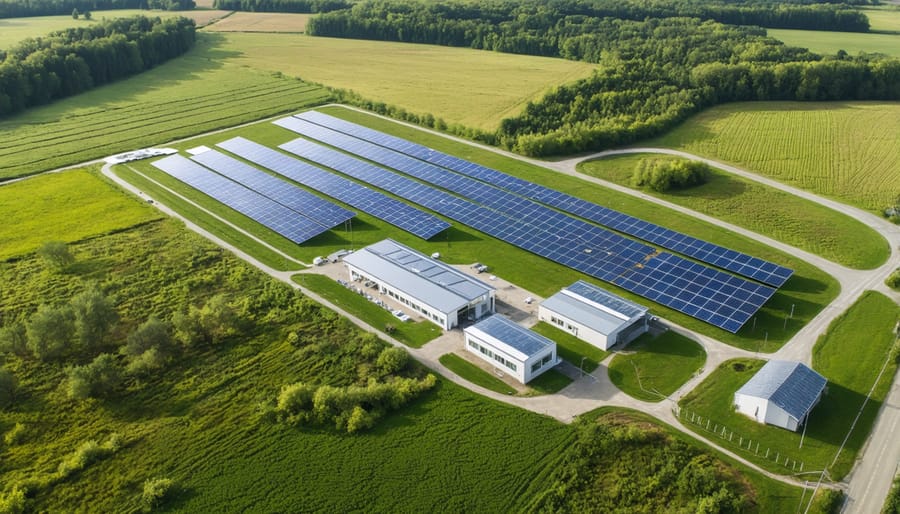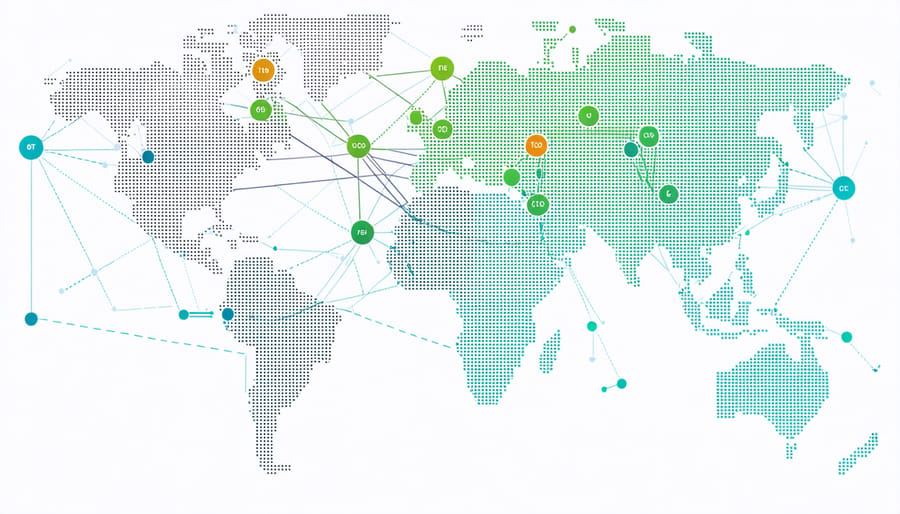Bioenergy research centers are revolutionizing Australia’s renewable energy landscape, connecting local innovation with global bioenergy networks to tackle climate change head-on. From converting agricultural waste into clean fuel to developing next-generation biomass technologies, these centers serve as crucial bridges between scientific discovery and practical implementation. Their collaborative approach brings together farmers, researchers, and industry leaders, creating a powerful ecosystem that’s already delivering remarkable results. With Australia’s abundant biomass resources and world-class research facilities, these centers are perfectly positioned to drive the transition towards a sustainable energy future. They’re not just laboratories; they’re catalysts for economic growth, environmental protection, and rural development, offering solutions that benefit both local communities and the planet.
The Power of International Bioenergy Research Hubs
Leading Global Research Centers
Several pioneering research facilities around the globe are driving innovation in bioenergy development. The US Department of Energy’s National Renewable Energy Laboratory (NREL) in Colorado leads groundbreaking work in biomass conversion and sustainable aviation fuels. Their state-of-the-art facilities have helped develop cutting-edge processes that are now used worldwide.
In Europe, the Netherlands’ Energy Research Centre (ECN) specialises in biomass gasification and waste-to-energy technologies, while Sweden’s Bio4Energy program at Umeå University focuses on forest-based biofuels. These centres have been instrumental in advancing sustainable forestry practices for bioenergy production.
Closer to home, CSIRO’s Australian National Bioenergy Research Institute partners with international facilities to develop solutions tailored to our unique ecosystem. Their work on agricultural waste conversion has sparked global interest, particularly in drought-resistant feedstock development.
Brazil’s CTBE (Brazilian Bioethanol Science and Technology Laboratory) has revolutionised sugarcane-based biofuel production, creating efficient processes that many countries now seek to adopt. Their success demonstrates how regional expertise can drive global innovation in the bioenergy sector.

Cross-Border Innovation Networks
International collaboration has become a cornerstone of bioenergy research advancement, with remarkable partnerships spanning continents. The Australia-Nordic BioNetwork stands out as a shining example, connecting Australian researchers with counterparts in Sweden, Finland, and Denmark to develop more efficient biomass conversion technologies. This partnership has already yielded breakthrough innovations in eucalyptus waste processing, leveraging Australia’s unique forestry resources.
Another notable success story is the Pacific Rim Bioenergy Alliance, where Australian scientists work alongside teams from Japan, South Korea, and the United States. Their collective efforts have produced promising results in algae-based biofuel production, particularly suited to Australia’s coastal regions.
These networks facilitate knowledge exchange through annual symposiums, researcher exchange programs, and shared laboratory facilities. The Trans-Tasman Bioenergy Initiative, launched in 2019, demonstrates the power of regional cooperation, with Australian and New Zealand research centers pooling resources to tackle common challenges in agricultural waste conversion.
By participating in these cross-border networks, Australian research centers have accelerated their progress while contributing valuable expertise to global bioenergy solutions. These partnerships continue to attract funding and talent, creating a robust ecosystem for sustainable energy innovation.
Australian Opportunities in Global Bioenergy Research
Strategic Research Partnerships
International collaboration is proving instrumental in revolutionizing green energy future initiatives across the globe. Australian bioenergy research centers are uniquely positioned to forge powerful partnerships with leading institutions worldwide, creating a network of knowledge exchange and innovative solutions.
Key partnership opportunities exist with established centers in Europe, particularly the Danish Bioenergy Center and Germany’s DBFZ, which offer complementary expertise in biomass conversion and waste-to-energy technologies. These collaborations enable Australian researchers to access cutting-edge facilities while sharing our unique insights into drought-resistant feedstocks and large-scale agricultural waste management.
In the Asia-Pacific region, emerging partnerships with Japan’s Biomass Technology Innovation Center and China’s National Center for Bioenergy Research present valuable opportunities for cross-cultural knowledge exchange. These relationships are particularly beneficial for developing region-specific solutions and adapting technologies to diverse climatic conditions.
North American partnerships, especially with the US Department of Energy’s Bioenergy Research Centers, offer access to advanced genomic research and biotechnology applications. These collaborations help accelerate the development of new feedstock varieties and processing methods suitable for Australian conditions.
Strategic partnerships also extend to industry players, with many international companies keen to test and implement new technologies in Australia’s diverse environmental conditions. This creates a perfect testing ground for innovative solutions while providing practical pathways for commercialization.
To maximize these opportunities, Australian centers are developing flexible partnership models that accommodate different scales of collaboration, from joint research projects to staff exchanges and shared patent development. This approach ensures sustainable, long-term relationships that benefit all parties while advancing global bioenergy solutions.

Resource Sharing and Knowledge Exchange
International collaboration stands at the heart of successful bioenergy research, creating a powerful ripple effect across the global scientific community. Research centers worldwide are increasingly recognizing that sharing resources, knowledge, and expertise leads to faster breakthroughs and more innovative solutions in the bioenergy sector.
The benefits of this collaborative approach are particularly evident in Australia, where research centers have formed strong partnerships with institutions across Asia, Europe, and North America. These partnerships have enabled Australian researchers to access cutting-edge facilities and technologies that might otherwise be beyond reach, while sharing our unique expertise in drought-resistant crops and sustainable farming practices.
A brilliant example of this cooperation in action is the virtual laboratory network connecting researchers from Melbourne to Munich, allowing real-time data sharing and joint experiments. This digital collaboration has cut research timelines in half and significantly reduced costs for participating institutions.
Resource sharing extends beyond just equipment and facilities. Research centers regularly exchange staff through fellowship programs, creating valuable opportunities for cross-pollination of ideas. These exchanges have led to breakthrough discoveries in biofuel production methods and innovative approaches to biomass processing.
Knowledge sharing platforms have also transformed how research centers operate. Regular international symposiums, both virtual and in-person, enable researchers to present findings, challenge assumptions, and build upon each other’s work. The annual Pacific Rim Bioenergy Conference, for instance, has become a cornerstone event for showcasing Australian innovations while learning from international peers.
This collaborative approach ensures that advances in bioenergy research benefit not just individual institutions but the global scientific community as a whole, accelerating our progress toward a sustainable energy future.
Success Stories: International Bioenergy Collaboration
Breakthrough Projects
Several groundbreaking projects have emerged from bioenergy research centers, showcasing the power of international energy innovation and collaboration. The CSIRO’s breakthrough in converting agricultural waste into sustainable aviation fuel stands as a prime example, transforming sugar cane bagasse into high-grade biofuel through an innovative fermentation process.
In Western Australia, researchers successfully developed a novel algae-based biofuel system that achieves twice the yield of traditional methods while using 50% less water. This game-changing technology has attracted global attention and is now being scaled up for commercial application.
The Queensland-based Mackay Renewable Biocommodities Pilot Plant demonstrated exceptional results in converting eucalyptus biomass into biofuel, creating a uniquely Australian solution that capitalizes on native resources. Their process achieved a remarkable 85% conversion efficiency, setting new industry standards.
Another milestone came from the collaboration between Victorian researchers and international partners, who developed a groundbreaking enzyme cocktail that breaks down stubborn plant matter in record time. This innovation has reduced processing costs by 40% and opened new possibilities for efficient biofuel production.
These achievements showcase how Australian ingenuity, combined with global expertise, is rapidly advancing the bioenergy field, creating practical solutions for a sustainable future.
Local Impact, Global Reach
Australian bioenergy research centers are creating ripples that extend far beyond our shores while delivering tangible benefits to local communities. Through strategic partnerships with leading international institutions, these centers bring global expertise and innovation directly to Australian soil.
In regional Victoria, collaboration between local researchers and European biomass experts has led to innovative farming practices that help drought-affected farmers diversify their income through bioenergy crops. These partnerships have created new jobs and strengthened rural economies, while contributing to global knowledge sharing in sustainable agriculture.
The impact is equally significant in Queensland, where joint ventures with Asian research facilities have revolutionized sugarcane waste processing. Local mills now transform agricultural residues into valuable biofuels and biochemicals, creating sustainable employment opportunities while reducing environmental impact.
These international connections also facilitate technology transfer that benefits Australian industries. For instance, Swedish waste-to-energy expertise has helped Perth-based facilities optimize their operations, resulting in more efficient waste management systems and reduced landfill use.
The two-way flow of knowledge ensures that Australian innovations reach global markets while international best practices enhance local operations. This exchange has positioned Australia as a key player in the global bioenergy landscape, attracting international investment and creating opportunities for local businesses to expand internationally.
Through these collaborations, Australian communities gain access to cutting-edge technology, create sustainable jobs, and contribute to global climate solutions – proving that local action truly can have global impact.
Future Pathways for Australian Bioenergy Research

Emerging Research Areas
Bioenergy research centers are increasingly focusing on groundbreaking areas that promise to revolutionize renewable energy production. Algal biofuels stand out as a frontier technology, with Australian researchers leading investigations into native species that thrive in our unique climate conditions. These studies are contributing to global sustainable clean energy innovation efforts.
Waste-to-energy conversion technologies are evolving rapidly, with promising developments in anaerobic digestion and thermal conversion processes. Research centers are exploring novel bacterial strains that can break down agricultural waste more efficiently, potentially transforming Australia’s abundant farm residues into valuable energy resources.
Cross-disciplinary collaboration between biotechnology and engineering teams is opening new possibilities in genetic optimization of energy crops. This includes developing drought-resistant varieties suitable for marginal lands, ensuring energy production doesn’t compete with food agriculture.
Emerging opportunities also exist in the integration of artificial intelligence and machine learning for optimizing bioenergy production systems. These technologies are helping researchers predict yield patterns, improve process efficiency, and reduce operational costs.
The development of mobile bioenergy units for remote communities represents another exciting research direction, particularly relevant for Australia’s outback regions. These portable systems could provide sustainable energy solutions while creating local employment opportunities and supporting regional development.
Building Sustainable Partnerships
Building successful international partnerships in bioenergy research requires a thoughtful, long-term approach that goes beyond simple collaboration agreements. Australian research centers have found particular success by establishing “sister center” relationships with facilities in Asia and Europe, creating opportunities for knowledge exchange and shared resources.
The key to sustainable partnerships lies in developing mutual benefit frameworks. Successful centers typically begin with small-scale joint projects, allowing relationships to grow organically before committing to larger initiatives. This “fair dinkum” approach has proven especially effective in maintaining long-term international connections.
Regular virtual conferences and rotating researcher exchange programs help maintain momentum and personal connections between partner institutions. Many Australian centers have implemented “digital first” collaboration tools, enabling real-time data sharing and project management across time zones. This approach has proven particularly valuable during global disruptions.
Financial sustainability remains crucial for long-term success. Leading centers often establish diverse funding streams, combining government grants with industry partnerships and joint commercialization ventures. The “hub and spoke” model, where a central research facility connects with multiple international partners, has emerged as a particularly effective structure.
Cultural awareness and sensitivity play vital roles in building lasting partnerships. Successful centers invest in cross-cultural training for their teams and establish clear communication protocols that respect different working styles and time zones. This attention to relationship-building has helped Australian bioenergy research centers become valued partners in the global research community.
The future of bioenergy research lies in our ability to work together across borders, sharing knowledge and resources to accelerate innovation. Australia’s unique position in the Asia-Pacific region, combined with our world-class research facilities and abundant biomass resources, positions us perfectly to become a leading force in international bioenergy collaboration.
Success stories from existing partnerships demonstrate the power of international cooperation. From developing more efficient conversion technologies with European research centers to exploring novel feedstock solutions with Southeast Asian partners, these collaborations have already yielded promising results that benefit all participants.
Now is the time for Australian stakeholders to step up and embrace these global opportunities. Industry leaders can forge new partnerships with international research centers, while government bodies can strengthen policy frameworks that support cross-border collaboration. Research institutions should actively seek international funding opportunities and exchange programs, creating pathways for knowledge sharing and innovation.
For individuals and organizations interested in joining this global movement, the first step is to connect with existing networks and research centers. Whether through attending international conferences, participating in joint research projects, or establishing formal partnerships, every contribution helps build a stronger, more sustainable future for bioenergy.
By working together, we can accelerate the development of bioenergy solutions that address both local and global challenges. The path forward is clear – through international collaboration, Australia can play a pivotal role in shaping the future of sustainable energy.

